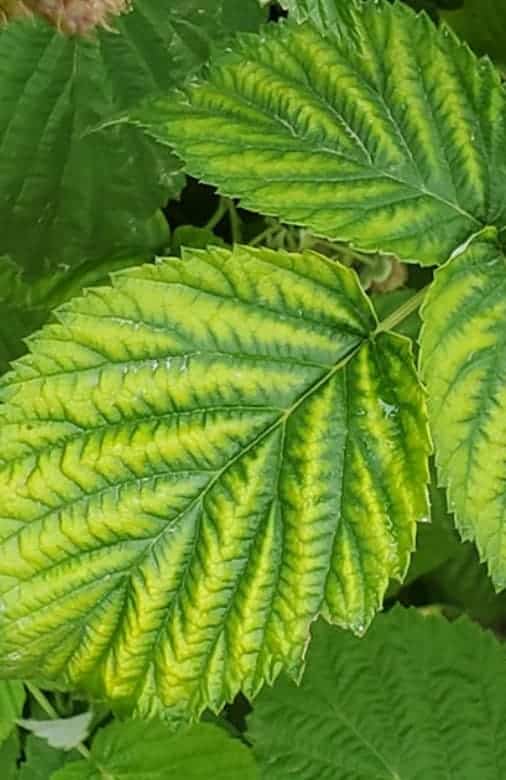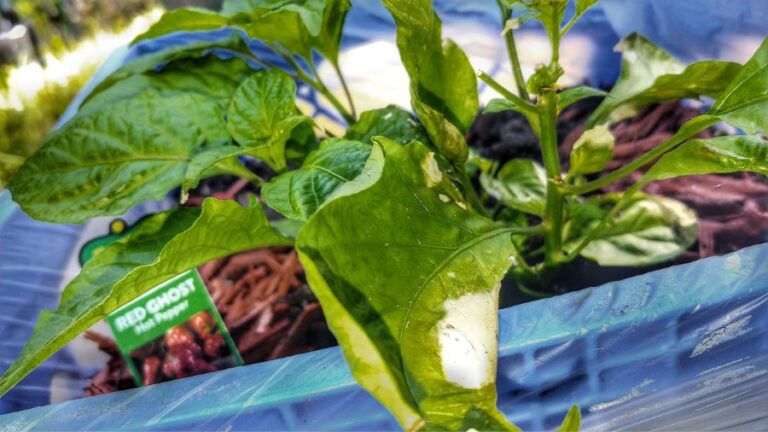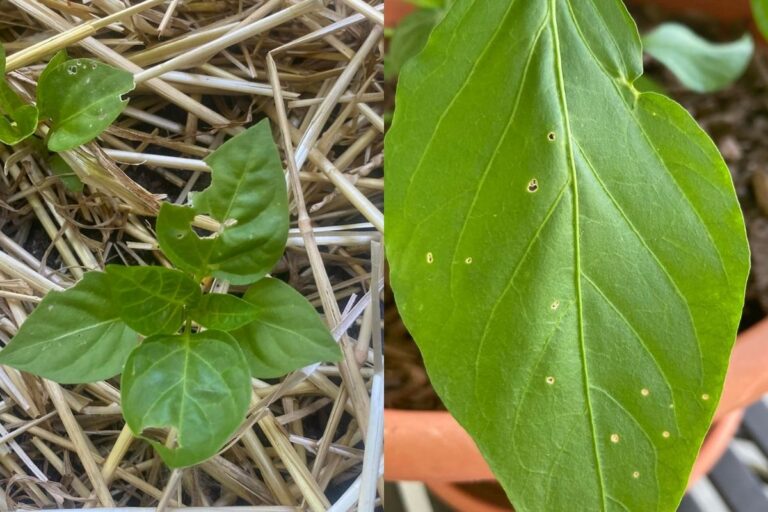Chlorosis on Raspberry Leaves (And How to Fix It)
The yellowing of raspberry leaves, regardless of the cause, always leads to a decrease in chlorophyll content. This is why the condition is named “chlorosis.” The chlorophyll deficiency in plants can result from a lack of essential nutrients or a viral infection.
Let’s dive into the reasons and treatment methods.

Physiological Chlorosis
Non-viral (physiological) chlorosis impacts raspberry plants due to the lack of necessary nutrients in the soil, such as iron, manganese, boron, and others.
This nutrient deficiency often gets worse with unfavorable weather conditions, all contributing to the development of chlorosis.
Excessive moisture and even watering with very cold water can cause non-viral chlorosis.


- Nitrogen: When the raspberry plant lacks nitrogen, the leaves fade, gain a yellowish tint, and dry up around the edges. Over time, such leaves die off completely.
- Iron: A deficiency in iron causes the young leaves to turn yellow first, followed by the older ones. The edges of the leaves turn a brown color.
- Boron: Chlorosis starts from the older leaves, showing up from the stalk and gradually moving to the tip of the leaf.
- Magnesium: Deficiency manifests as yellow spots across the entire leaf, and the young shoots grow very slowly. The leaves vein remains green, which is a surefire sign of magnesium deficiency.
- Manganese: Deficiency reveals itself by yellowing older leaves between the veins while the young leaves remain green.
To help the raspberry plant recover quickly, you must conduct foliar feeding, allowing the plants to replenish the necessary elements quickly. Up to 100% of the nutrients can be absorbed through the leaves.
Nutrient Deficiency Treatment
Tackling Nitrogen Chlorosis
Grab a leaf fertilizer loaded with nitrogen to whip nitrogen chlorosis into shape and give the plant leaves a good spray.
After the treatment, mark your calendar for a 20-day countdown (that’s when you can finally taste those juicy berries again).
Raspberries are fond of acidic soil, so if you’re battling chlorosis due to nitrogen deficiency, Ammonium Sulfate fertilizer might be your best ally.
Not only does it help maintain the soil’s acidity, but it also supplies the much-needed nitrogen to keep your berries happy.
Combating Boron Deficiency
Just spritz your plants with a boron-packed leaf fertilizer or some boric acid.
Give your leaves a friendly boron boost 2-3 times throughout the growing season and even as a preventive measure: during the budding phase, when the flowers bloom, and as the berries start to form.
Trust me; your plants will thank you with plentiful fruit, higher sugar content, and perfectly ripe berries.
Ironing out Iron Deficiency
Bring out the big guns with an iron chelate foliar feed. Give it about ten days, then feel free to give them another round of the good stuff.
Managing Manganese Deficiency
They’ll need a few rounds of manganese chelate foliar feeds to return your plants from manganese deficiency.
Remember to follow the manufacturer’s instructions for diluting it – we don’t want overzealous feeding here!
Magnesium Deficiency? No More!
Magnesium deficiency doesn’t stand a chance against our plant-loving powers!
All it takes is a nice foliar feeding with a fertilizer packed with magnesium. Your plants will be back to their old selves in no time!
Viral Chlorosis
This is a dangerous disease transmitted by pests. It’s identifiable by the yellowing of the leaf veins, after which the leaves themselves become covered with a yellow network.
Sometimes, the leaves just develop yellow spots and then curl up, all depending on the strain of the virus. When harvest time rolls around, you’ll find the berries are dry, small, and practically inedible.
Chlorosis virus spreads through grafting, infected seedlings, and sucking insects (aphids, thrips).
Preventing Chlorosis

Preventing chlorosis is incredibly important, especially regarding its viral form. Because agronomists haven’t yet developed reliable ways to guarantee its cure.
Physiological and viral chlorosis exhibit very similar symptoms, but in the former case, treatment yields quick results.
Meanwhile, curing infectious chlorosis is almost impossible – it’s best to uproot and burn the bushes affected by the disease.
Here are the main preventative measures for chlorosis in raspberries:
- It’s a good idea to purchase raspberry varieties resistant to vein chlorosis.
- Avoid planting raspberries in areas with water stagnation.
- Mulch the root zone or frequently hoe and loosen the soil, maintaining an optimal water balance.
- Controlling weeds reduces the risk of infection through aphids, which tend to form colonies in dense grass.
There are other causes besides chlorosis for the yellowing of raspberry leaves. I’ve outlined the hands-on solutions to this issue in my other article.




